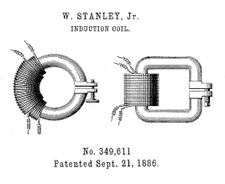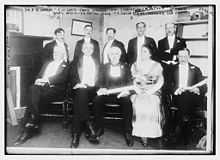William Stanley, Jr.
| William Stanley, Jr. | |
|---|---|
 | |
| Born | November 28, 1858 |
| Died | May 14, 1916 (aged 57) |
| Fields | Electrical engineering |
| Notable awards | IEEE Edison Medal (1912) |
William Stanley, Jr. (November 28, 1858–May 14, 1916) was an American physicist born in Brooklyn, New York. In his career, he obtained 129 patents covering a variety of electric devices.[1] In 1913, he also patented an all-steel vacuum bottle, and formed the Stanley Bottle Company.
Biography
Stanley was as an electrician working with tele keys and fire alarms of an early manufacturer. In Philadelphia, Stanley designed one of the first electrical installations (at a Fifth Avenue store). Shortly thereafter, George Westinghouse hired Stanley as his chief engineer at his Pittsburgh factory.
In 1885, Stanley built the first practical alternating current device based on Lucien Gaulard and John Dixon Gibbs' idea. This device was the precursor to the modern transformer. In December, under a new contract with Westinghouse, Stanley moved his operations to Great Barrington, Massachusetts.[2]
In 1886, on March 20, Stanley demonstrated the first complete system of high voltage Alternating Current transmission, consisting of generators, transformers and high-voltage transmission lines. His system allowed the distribution of electrical power over wide areas. He used the system to light offices and stores along the main street of Great Barrington - the location of his West Avenue family home. Stanley's transformer design became the prototype for all future transformers, and his AC distribution system formed the basis of modern electrical power distribution. He was the first person to make an electrical transformer, and his work in the electrification of Great Barrington's Main Street was named an IEEE Milestone.[3]
Agreeing that the AC system had arrived, Westinghouse further tested the system in summer 1886 in Pittsburgh; it transmitted over a distance of 3 miles, and used an alternator designed by Stanley to replace the Siemens model, which regulated voltage poorly. Satisfied with the pilot system, Westinghouse began commercial production and shipped his company's first commercial to Buffalo NY, where a local utility placed it in service. Orders for 25 alternating-current plants followed within months.[2]
In 1890 Stanley founded the Stanley Electric Manufacturing Company in Pittsfield, Massachusetts. In 1903 the General Electric Corporation purchased a controlling interest in the firm. The land on which the company once stood is now the site of the William Stanley Business Park of the Berkshires in Pittsfield.[4]
Patents

William Stanley, Jr. was granted 129 patents for a range of products and electrical devices.[1][5] A selection of patents follow. Significant patents are in bold.
- U.S. Patent 244,331, Circuit-closer for incandescent lamps
- U.S. Patent 269,132, Electric lamp
- U.S. Patent 316,302, Filament for incandescent electric lamps
- U.S. Patent 322,496, Multiple incandescent electric lamp
- U.S. Patent 323,372, Carbon for incandescent lamps
- U.S. Patent 324,894, Socket for incandescent electric lamp
- U.S. Patent 330,269, Holder for incandescent electric lamp
- U.S. Patent 333,028, Globe for incandescent electric lamp
- U.S. Patent 349,611, Induction coil
- U.S. Patent 349,613, Automatic cut-out for electric-lighting circuits
- U.S. Patent 349,614, Automatic cut-out for electric-lighting circuit
- U.S. Patent 363,559, Incandescent electric lamp [6]
- U.S. Patent 333,564, System of electric lighting
- U.S. Patent 387,117
- U.S. Patent 428,575
- U.S. Patent 508,188
Further reading
- "William Stanley Dies", New York Times, May 15, 1916, pg 9, col 5.
- "William Stanley" (Nov.22, 1858-May 14, 1916), Dictionary of American Biography, Vol XVII, Charles Scribner's Sons, New York, 1935, pg 514.
- "William Stanley", The National Cyclopedia of American Biography, Vol XXIV, James T. White & Co., New York, 1935, pg 394.
- William Stanley (1858–1916) — His Life and Work, Laurence A. Hawkins, The Newcomen Society in North America, New York, 1951.
References
- ↑ 1.0 1.1 Owen, E.L., Rediscovering William Stanley, Jr. Part I, Industry Applications Magazine, IEEE, Nov.-Dec. 2003 Volume 9, Issue 6 pg 9- 12 ISSN 1077-2618 INSPEC 7949020 DOI 10.1109/MIA.2003.1245790
- ↑ 2.0 2.1 Thomas Parke Hughes, Networks of Power: Electrification in Western Society, 1880-1930, p.103-104, (1993)
- ↑ "Milestones:Alternating Current Electrification, 1886". IEEE Global History Network. IEEE. Retrieved 27 July 2011.
- ↑ William Stanley Business Park
- ↑ Stanley
- ↑ This is the 1886 Stanley-Westinghouse Lamp
External links
- ejcov, William Stanley, Jr.
- IEEE Legacies William Stanley, Jr
- United States Circuit Courts of Appeals Reports. West. 1908., 1908. P. 348
- AboutInventors; William Stanley
- How Stanley's design formed the basis of modern Transformers
Images
| ||||||||||
